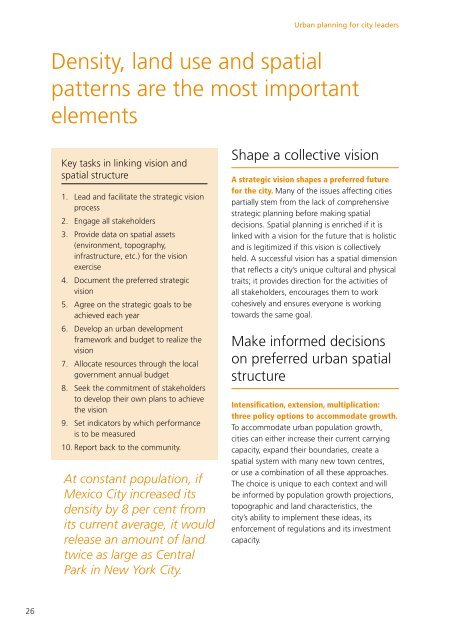Urban Planning for City Leaders - Cities Alliance
Urban Planning for City Leaders - Cities Alliance
Urban Planning for City Leaders - Cities Alliance
Create successful ePaper yourself
Turn your PDF publications into a flip-book with our unique Google optimized e-Paper software.
<strong>Urban</strong> planning <strong>for</strong> city leadersDensity, land use and spatialpatterns are the most importantelementsKey tasks in linking vision andspatial structure1. Lead and facilitate the strategic visionprocess2. Engage all stakeholders3. Provide data on spatial assets(environment, topography,infrastructure, etc.) <strong>for</strong> the visionexercise4. Document the preferred strategicvision5. Agree on the strategic goals to beachieved each year6. Develop an urban developmentframework and budget to realize thevision7. Allocate resources through the localgovernment annual budget8. Seek the commitment of stakeholdersto develop their own plans to achievethe vision9. Set indicators by which per<strong>for</strong>manceis to be measured10. Report back to the community.At constant population, ifMexico <strong>City</strong> increased itsdensity by 8 per cent fromits current average, it wouldrelease an amount of landtwice as large as CentralPark in New York <strong>City</strong>.Shape a collective visionA strategic vision shapes a preferred future<strong>for</strong> the city. Many of the issues affecting citiespartially stem from the lack of comprehensivestrategic planning be<strong>for</strong>e making spatialdecisions. Spatial planning is enriched if it islinked with a vision <strong>for</strong> the future that is holisticand is legitimized if this vision is collectivelyheld. A successful vision has a spatial dimensionthat reflects a city’s unique cultural and physicaltraits; it provides direction <strong>for</strong> the activities ofall stakeholders, encourages them to workcohesively and ensures everyone is workingtowards the same goal.Make in<strong>for</strong>med decisionson preferred urban spatialstructureIntensification, extension, multiplication:three policy options to accommodate growth.To accommodate urban population growth,cities can either increase their current carryingcapacity, expand their boundaries, create aspatial system with many new town centres,or use a combination of all these approaches.The choice is unique to each context and willbe in<strong>for</strong>med by population growth projections,topographic and land characteristics, thecity’s ability to implement these ideas, itsen<strong>for</strong>cement of regulations and its investmentcapacity.26
















